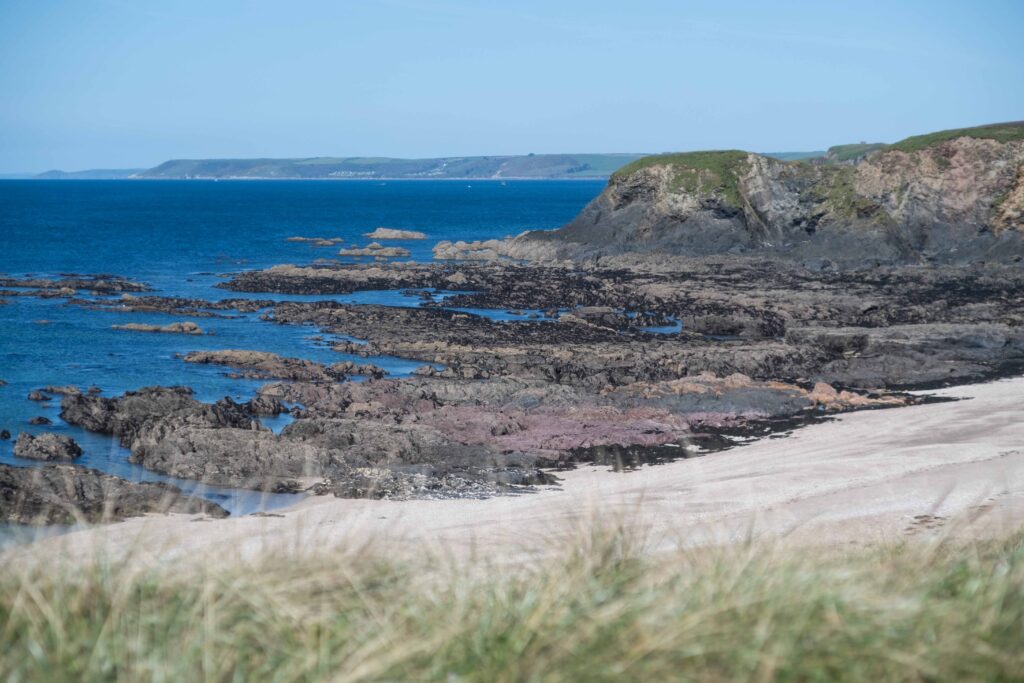Fish
Revised text about to be added from WRT
1. About
Key pressures and opportunities
Weirs and other structures can create barriers and prevent migratory fish moving from the sea to their spawning beds in rivers. Structures in rivers can also affect habitat. For example, they can change the flow and move gravel on the riverbed. Hydropower turbines and pumping stations can trap fish, leading to injury or death.
It can be hard to remove barriers including due to the historic value of weirs. However, fish passes can overcome many of these problems.
Species such as salmon are highly sensitive to water quality. Excess nutrients entering the watercourse reduce water quality. Increased sediment load can smother fish and prevent them from successfully spawning or make eggs less likely to hatch and produce healthy fish fry (MORE TO ADD)
Many riparian corridors are now overgrazed or left unmanaged. This can create large open sections of river that are prone to higher water temperatures or heavily shaded areas that reduce the amount of sunlight getting to the river. This in turn restricts the growth of plants and algae which are food for fish and for the invertebrates they feed on.
To be added during Consultation.
To be added during Consultation.
To be added during Consultation.
To be added during Consultation.
To be added during Consultation.
To be added during Consultation.
There is growing community interest in wildlife and rivers, in particular about water pollution. Westcountry Rivers Trust runs a citizen science project where volunteers monitor and collect data on river health.
There are lots of projects across Devon that provide opportunities for fish conservation, many led by the Environment Agency and Westcountry Rivers Trust. See Inspiration and Find out more below for more information.
2. What we need to do and where
Priority
Increase the abundance and distribution of populations of fish in Devon’s freshwater and intertidal habitats, in particular those identified as Focus Species.
See Find out more below for any relevant national and local targets.
Focus Species
The eleven Focus Species are discussed below. Nine species which largely migrate between the sea and rivers have been grouped together as they need similar actions. The two seahorses are also grouped together.
Migratory fish
Allis shad and twaite shad
Alosa alosa and Alosa fallaxHabitat
Both shad species are members of the herring family and move from the sea into rivers to spawn between April and June. They spawn in shallow areas near deeper pools and the eggs sink between the coarse gravel and cobbles of the riverbed. Their habitat needs are still not fully understood.
Population
Though once widespread, in recent decades both species have declined significantly and they’re now listed as endangered in the UK. The River Tamar (below and just above Gunnislake Weir) is the only known spawning river for allis shad in the UK. They’re also known in the Taw and DNA testing is being carried out to confirm spawning.
Although twaite shad are more widespread, the only Devon records are in the Taw. Both species are weak swimmers and unable to leap over weirs and other barriers which can prevent them from reaching upstream spawning grounds. Other pressures include water quality, river modification and bycatch.
Atlantic salmon
Salmo salarHabitat
Atlantic salmon move from the sea to spawn in the upper reaches of rivers where there is clean, cooler, fast-flowing water. They lay their eggs in shallow gravelly areas in nests called redds. Adult salmon die after spawning. Juveniles stay in freshwater for up to six years, after which they migrate back to the sea. They feed on invertebrates and small fish.
Population
Wild Atlantic salmon populations are in crisis, having declined by 70% in the last 25 years. In the 1980s there were 8-10 million adult salmon in the North Atlantic. Today there are 2-3 million.
There are 13 principal salmon rivers in Devon: the Axe, Exe, Teign, Dart, Avon, Erme, Yealm, Plym, Tavy, Taw, Torridge, Lyn, and Tamar. In 2022 all were classified as ‘At risk’ apart from the Tamar and Lyn which were ‘Probably at risk’. Particular pressures in Devon include barriers, water quality (salmon are very sensitive to pollution), sediments smothering gravel beds, higher water temperatures and flows.
Sea and brown trout
Salmo trutta morpha trutta / Salmo truttaHabitat
Sea and brown trout are the same species which spawn in xxxxxx. Unlike salmon, trout don’t die after spawning. Some stay in rivers and are known as brown trout and others migrate out to sea and are known as sea trout. Many return to the same river to spawn, generally between June and October.
Population
Due to the decline in sea and brown trout populations, byelaws have been put in place restricting the number of fish that can be kept and killed. Much of the data held on sea trout stocks in the UK is from fishermen who hold rod catch licences. In Devon the Avon, Plym and Torridge are now classified as ‘At risk’ with the Dart, Erme, Yealm, Tavy, Tamar, Taw and Lyn classified as ‘Probably at risk’. Pressures for trout are very similar to those for salmon.
Sea lamprey, brook lamprey and river lamprey
Petromyzon marinus, Lampetra planeri and Lampetra fluviatilisHabitat
Lampreys are an ancient order of jawless fish. They have a circular disc-shaped mouth, which sea lamprey use to attach themselves to a host fish they then feed on. Brook lamprey live in freshwater while river and sea lamprey spawn in freshwater and feed in coastal waters. However, it’s now thought that brook and river lamprey could be the same species, with some fish staying in freshwater and some evolving to be able to migrate out to sea (similar to brown and sea trout).
Population
All three species are of international conservation concern. Brook lamprey is legally protected and all are UK Priority Species. There are no specific lamprey surveys in Devon, but an analysis of Environment Agency data from 1965-2024 showed that brook lamprey are likely to occur in most of Devon’s catchments, sea lamprey were found in the Taw and north Devon catchment and river lamprey in the Lim, Axe and Torridge catchments.
The main pressures are river barriers preventing access to their spawning gravels, pollution and loss of habitat through straightening and deepening channels in rivers.
Eels
Anguilla anguillaHabitat
Eels follow an opposite lifecycle to salmon, trout, shad and lamprey. They spawn in the Sargasso Sea and then travel across the Atlantic to mature in rivers for up to 20 years before they return to their spawning ground. They have a broad diet that includes fish, molluscs and crustaceans and are also known to scavenge dead fish.
Population
Eels are found in rivers across Devon. However, they’ve seen huge declines and are now critically endangered in Great Britain – talk to EA and add key reasons (barriers loss of habitat, issues elsewhere?)
Actions
See Watercourses for actions for water quality, riparian zone, invasives and in-channel habitat.
Remove barriers to improve fish passage or mitigate by other means
- Prioritise barriers which could be removed or where fish passes can be installed, building on the Environment Agency’s priority barrier database and AMBER (Adaptive Management of Barriers in European rivers).
- Produce a Devon map of priority fish barriers similar to the Essex Fish Migration Roadmap
Bycatch and overfishing
Discuss with EA and WCRT
Research and monitoring
Discuss with EA and WCRT
Funding
Discuss with EA and WCRT
The actions for seahorses below are also relevant to these migratory species as they depend on healthy estuarine environments at some stage in their lives.
Where to focus action
High Opportunity Areas:
- All watercourse corridors – The fish Focus Species occur in most of Devon’s watercourses. Actions relating to water quality, riparian zone, barriers, invasives and in-channel enhancements are therefore needed across all watercourses and their riparian zones. They’re all mapped as High Opportunity Areas. See Watercourses for more information.
- Full river restoration (FRR) rivers – Investment should be targeted to the rivers where full river restoration actions have the greatest chance of success. These rivers were chosen using criteria that included the status of the fish Focus Species. See Watercourses for more information.
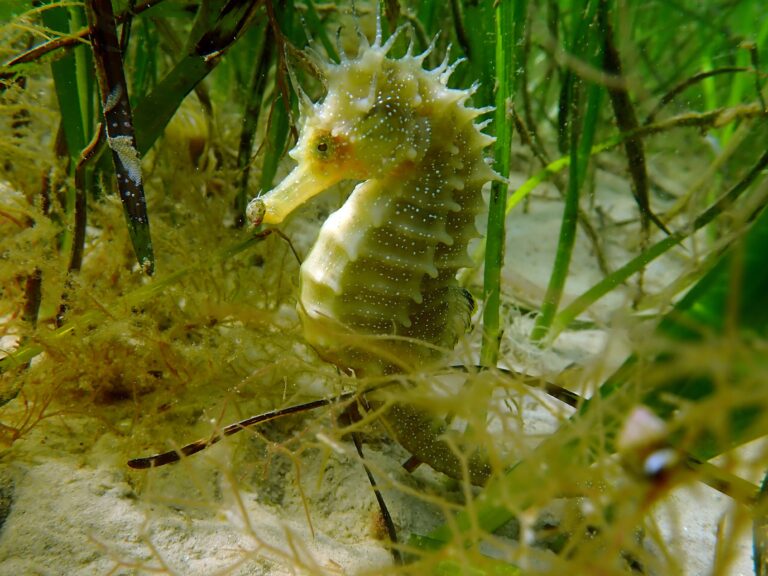
Seahorses
Seahorses lead solitary and secretive lives in sheltered, shallow, coastal waters. The spiny seahorse and short-snouted seahorse can be found in the seagrass beds of Torbay, Plymouth, the Exe Estuary and Kingsbridge (confirm with intertidal group). They’re well-camouflaged, blending seamlessly into their surroundings and using their tails to anchor themselves to seagrass blades where they prey on small crustaceans such as shrimp and crabs.
One of the most intriguing aspects of seahorses is how they reproduce. Unlike most fish, the males carry the fertilised eggs in a special brood pouch and give birth to live young.
Devon’s seahorses are both endangered species due to habitat destruction, especially the loss of seagrass meadows. Seahorses are often caught as bycatch in trawl fisheries and are also globally harvested for traditional medicine. The demand globally for seahorses in traditional medicine and the aquarium trade is higher compared to many other fish species.
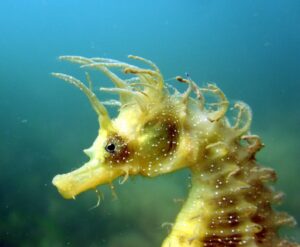
Spiny (long-snouted) seahorse
Hippocampus guttulatusTo be finalised during pre-consultation.
The spiny (long-snouted) seahorse has a slender, elongated body with a long snout and typically measures between 18cm and 20cm in length, although many are recorded to be larger. Its coloration ranges from dark green to brown and yellow, often speckled with small white dots. True to its name, this species is adorned with distinctive spiny protrusions along its head and back.
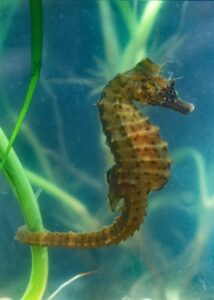
Short-snouted seahorse
Hippocampus hippocampusTo be finalised during pre-consultation.
The short-snouted seahorse can grow up to 15 centimetres long. It has a short, slightly upturned nose, and spiky bumps above its eyes. Its body is covered in hard, knobbly lumps, which give it a rough texture. These seahorses come in many colours, including brown, orange, purple, or black, and sometimes have light patches on their skin.
Actions
Protect and restore seagrass beds
- See Coastal Wildbelt for details.
Reduce pollution and litter
- Reduce pollution in coastal waters by, for example, improving waste management systems, reducing agricultural runoff and promoting the use of eco-friendly products. Support initiatives that aim to clean up plastic and other debris from marine environments.
- See Water Quality and Litter.
Improve and enforce legal protection
- Help safeguard seagrass meadows and other habitats by designating and managing Marine Conservation Zones (MCZs) in key seahorse habitats, such as Torbay.
- Strengthen and enforce existing regulations that protect seahorses and their habitats. This includes monitoring fishing practices to prevent bycatch, controlling coastal development and ensuring compliance with international agreements.
Awareness and engagement
- Raise awareness about the importance of seahorses and their habitats, including with tourism boards. Engage local communities and schools in citizen science projects, beach clean-ups, and activities to restore habitat.
- Modify fishing gear, for example by using larger mesh sizes or escape panels to help prevent seahorse bycatch.
Funding and support
- Provide financial and logistical support to organisations working to protect seahorses and their habitats.
- Encourage partnerships between government agencies, NGOs and private sector stakeholders to enhance conservation efforts.
- Trial eco-friendly moorings in seagrass areas.
Where to focus action
High Opportunity Areas: Existing seagrass beds and focus areas for restoration, including the Exe Estuary and Torbay. See Mapping.
Actions for all fish
See Watercourse corridors for actions for water quality, riparian zone, invasives and in-channel habitat.
Habitat management and creation
Fish will benefit from the actions set out on the Habitat pages, in particular:
3. Inspiration
Case studies
Westcountry Rivers Trust
The Westcountry Rivers Trust is leading a project to assess and map barriers on the River Teign. The project is funded through the government’s Water Environment Improvement Fund. They are also working to address barriers in the Exe catchment through the Strategic Exe Weirs project.
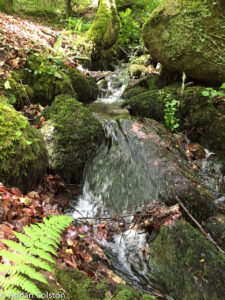
The Seahorse Trust
The Seahorse Trust focuses on the conservation and preservation of seahorses and their natural habitats. Through their British Seahorse Survey, the trust’s team has been conducting dives to monitor and protect Devon’s seagrass meadows.
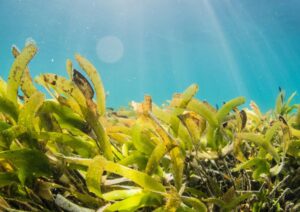
Where to visit
To be agreed during pre-consultation.
4. Find out more
To be finalised through Consultation
The AMBER project (adaptive management of barriers in European rivers) has a map of river barriers in Europe.
The Westcountry Rivers Trust has published a report on its study into the decline of adult trout in Dartmoor’s streams.
Roadford Mitigation Programme
SWW environmental mitigation commitments including Gravel augmentation
Strategic Exe Weirs
River Teign Restoration Project
Northern Devon Natural Solutions
Upstream Thinking
Strategic Teign Barriers
The Wild Trout Trust has information on the lifecycle of sea trout.
The SAMARCH project is a partnership between five organisations in England and five in France that work together to collect new information on the biology and ecology of migrating salmon and sea trout, to improve their protection in estuaries and coastal areas.
In 2008 the Atlantic Salmon Trust produced a booklet, Sea Trout Facts.
The Woodland Trust has a page on its website with information on brown trout.
The government produce an annual report on the status of salmon stocks and fisheries in England and Wales.
Natural England has published a research report:
Habitat mapping and monitoring of allis shad on the River Tamar – NERR1947
The Canal and River Trust has pages on its website with information on brook lamprey, river lamprey and sea lamprey.
NatureScot,Scotland’s nature agency, has a page on its website with information on lamprey.
To find out more about seahorses and work that’s taking place to conserve them, visit The Seahorse Trust and Project Seahorse.

